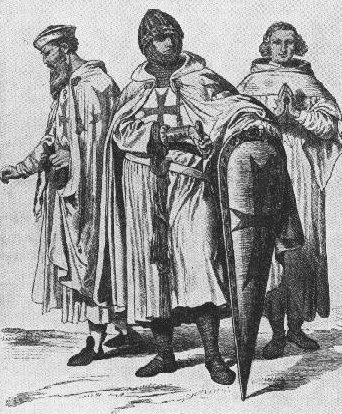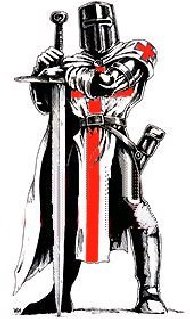
|
|||
Unexplained Mysteries - KNIGHTS OF TEMPLAR
Source :http://en.wikipedia.org/wiki/Charles_Manson
With the advent of the dAvINCI cODE, there appears to be a swelling tide of interest relating to the question as to whether the medieval Knights Templar in fact possessed the Holy Grail. The answer to this is a very simple one: There is no doubt whatsoever that the Templars possessed the Holy Grail. The explanation behind this answer, unfortunately, remains somewhat complicated and, to a degree, very speculative. The key, as I have learned during the writing of The Labyrinth Of The Grail, is toconstantly "look beyond" what appears at first to be the true answer. The simple reasoning is that why else would both the Church and State pursue the Templars to the far ends of the earth and torture them beyond compassion. Obviously, the accusations of blasmephy were only an excuse to justify their actions. It really doesn't take any skill to recognize that the inner circle of the Templars possessed something far more valuable than mere silver and gold - something that threatened the very being of the Church and State. Founding of the Knights Templar The First Crusade (1) Call for a Holy War "In medieval Europe "the ethics of the ruling class remained those of the Nibelungenlied and the Icelandic sagas. As late as the tenth century a heathen religious order called the Joms-Vikings appeared in Scandinavia, restricted to warriors of proven bravery who submitted to a harsh discipline, sleeping in barracks without women. Death in battle was their dearest ambition - to join Woden in Valhalla. The House-Carles who gave a grim an account of themselves at Hastings had been founded by King Sweyn Forkbeard, a former commander of these Jomsburg brethren, and many European noblemen had Scandinavian blood. The traditions of the northern war-band were very much alive in the twelfth century and the chansons de geste expressed the same pagan ideals: physical prowess, the joy of plunder and the duty of revenge." - Desmond Seward, The Monks of War The followers of the Warrior Cults of Northern Europe were feared for their frenzied ferocity in battle. Operating under a patchwork of warlords, they stood in the way of a pacified and united Europe operating under the Holy Roman Empire.
 Jerusalem - occupied by the Moslems since 638 - his appeal inspired extraordinary enthusiasm. Palestine's importance was heightened by the new appreciation of Christ's humanity; the scenes of the Passion were still pointed out at Jerusalem. That His City should belong to infidels was contrary to the law of God. And Holy War would provide a magnificent outlet for the destructive energy of barbarous nobles. "These saw the crusade as a summons by God to render military service and also as an opportunity to win new manors in the way they had been won in England and southern Italy. Shouts of 'Deus li volt' resounded throughout Europe and a great host of warlike pilgrims from all classes converged on the Holy Land singing the ancient, triumphant hymn 'Vexilla regis prodeunt' The king dressed in a golden burnous and keffiyeh and gave audiences cross-legged on a carpet. Nobles wore shoes with up-turned points, turbans, and the silks, damasks muslins and cottons that were so different from the wool and furs of France. In the towns they lived in villas with courtyards, fountains and mosaic floors, reclining on divans, listening to Arab lutes and watching dancing girls. They ate sugar, rice, lemons and melons and washed with soap in tubs or sunken baths, while their women used cosmetics and glass mirrors, unknown in Europe. Merchants, grown accustomed to bazaars, veiled their wives, and professional wailers were seen at Christian funerals. Coins had Arabic inscriptions....The climate, with its short but stormy winters and long sweltering summers, and the new diseases, caused heavy mortality despite Arab medicine. The majority of the population was Moslem. Life, perpetually overshadowed by the sinister specters of death, torture or slavery, could only be endured by men of strong self-discipline. In July 1099, the city of Jerusalem was attacked and stormed; the entire population murdered in a holocaust that lasted three days. 70,000 people died at the hands of the slaughterous heathens and the Knights Templar came into existence after this massAcre. Originally known as the Order of Poor Knights of the Temple of Solomon, they were a group of pious soldiers (many of whom were French) who decided to protect pilgrims on the dangerous roads between Jaffa (the place at which they landed in Palestine) and Jerusalem. This volunteer police force actually turned out to be comprised of noblemen like Hughes de Payens and Godefroi de Saint-Omer, men who wished to live a life of chastity. In return for providing protection to pilgrims, the church would offer them the remission of their sins. There are many myths surrounding the Knights Templar, particularly relating to the Temple of Solomon and the Holy Grail. They did indeed inhabit the temple at one time, when King Baldwin offered them temporary residence, but beyond this is there much truth in the stories that surround them? Was there a Templar treasure, as so many authors claim? How did they manage to become the world's most wealthiest and powerful organisation and what caused their downfall? Wolfram von Eschenback wrote a poem called Parzifal which related the tale of the Holy Grail and of the Knights Templar. At the time, in 1220, the Templars were still around and were probably a famous group of men and Eschenback was trying to tell us that they guarded the precious object. Indeed, if they had guarded pilgrims travelling to the Holy City, why shouldn't they take it upon themselves to look after the grail as well. By 1314 the Templars had transformed themselves into a body of men who were loathed by the church and certainly not admired for their heroic actions. On 18 March, Jacques Molay, the last Grand Master of the Order, Godffroi de Charney, the head of the Order in Normandy, and a third man were burned to death in Paris. It was claimed that they were devil worshippers - a rumour which seems to be untrue and which was almost certainly created to accentuate the charges of heresey brought against them. The simple facts were that they owned large tracts of valuable land which other people wanted to get their hands on! The Pope dissolved their order and warned that anyone thinking of joining would be excommunicated and charged as a heretic. The "Rubant Document" claims that the Templars were very advanced for their time, thanks to secret knowledge they had obtained from books. Somehow, the Knights had managed to find a sort of "complete and absolute knowledge", a secret wisdom that was only known to the initiated. Raoul de Presle, a lawyer from the time, said that there was a strict secret held within the Order, the nature of which was so sensational that men would prefer to have their heads chopped off rather than divulge it! What on earth was this secret? Jacques de Molay had told the Inquisition just before his death that he would like to tell them "certain things" but they weren't authorised to hear them. Did this involve the secret doctrine of the Templars, something that might threaten the very foundations of normal Christianity, or did it merely involve the guarding of an object? When the Knights Templar were founded in 1118-1119 in Jerusalem, it was a 'poor order' whose primary function was the protection of pilgrims along the main roads between the coast at Jaffa and the inland city of Jerusalem. But an important transformation took place when this nascent Order came under the patronage of St Bernard of Clairvaux, nephew of André de Montbard, one of the founding group of the Templars. Until his conversion at the age of twenty, St Bernard himself had been destined for a knightly career, and when he came to patronize the Knights Templar that Order was imbued with the ideals and convictions of the knightly class of Burgundy. It was Hugues of Champagne who donated the site of Clairvaux to Bernard, where he built his abbey and from whence he expanded his 'empire'. He became the official 'sponsor' of the Templars, and it was his influence that ensured papal recognition at the Council at Troyes, this being the capital of Hughes' land....It was a disciple of Bernard's, Pope Innocent II, (formerly a monk at Clairvaux) who freed the Templars from all allegiance to anyone except the Pope himself In 1128, Bernard of Clairvaux "was just twenty-eight years old when the Council of Troyes asked him to help create a Rule for the Templars. He did more than that. He became their most vocal champion, urging that they be supported with gifts of land and money and exhorting men of good family to cast off their sinful lives and take up the sword and the cross as Templar Knights St Bernard, who took a strong liking to Hughes, recognized a means of channeling the feudal nobility's surplus energy which would convert 'criminals and godless, robbers, murderers and adulterers'. He promised Hughes that he would compile a rule and find recruits. 'They can fight the battle of the Lord and indeed be soldiers of Christ'. Military Christianity had found it real creator Bernard urged young men to take up the Templar sword, comparing the Templar's holy way of life, so pleasing to God, to the degenerate ways of the secular knights, whose lives were dedicated to vanity, adultery, looting, and stealing, with many sins to atone for. The dedication to Christ, to a life of chastity and prayer, to a life that might be sacrificed in battle against unbelievers, was enough penance to atone for any sin or any number of sins. On that basis, Bernard appeared to sceleratos et impius, raptores et homicidas, adulteros, 'the wicked and the ungodly, rapists and murderers, adulterers', to save their own souls by enlisting as Kings of the Temple. That guaranteed absolution was also a way out for those suffering under decrees of excommunication. The taking of the Templar oath would evidence submission to the Church, and the supreme penance of a lifetime at war for the True Cross would satisfy God's requirement for punishment of the contrite. The warriors are gentler than lambs and fiercer than lions, wedding the mildness of the monk with the valour of the knight, so that it is difficult to decide which to call them: men who adorn the Temple of Solomon with weapons instead of gems, with shields instead of crowns of gold, with saddles and bridles instead of candelabra: eager for victory -- not fame; for battle not for pomp; who abhor wasteful speech, unnecessary action, unmeasured laughter, gossip and chatter, as they despise all vain things: who, in spite of their being many, live in one house according to one rule, with one soul and one heart Another pools of recruits was provided by the poor knights who lacked the funds to acquire horses, armor, and weapons. All of those things would be given to them upon their entry, along with personal attendants and servants. They were certain of adequate food and a place in which to live. Their self-respect, no matter how low it might have sunk, would be instantly restored....(A heavy war-horse cost roughly the equivalent of four hundred days' pay for a free laborer). comments powered by Disqus Submit News/Videos/Links | Discuss article | Article Link | More Unsolved and Unexplained Mysteries |
More can be addded on request. Direct your requests at vinit@theunexplainedmysteries.com
